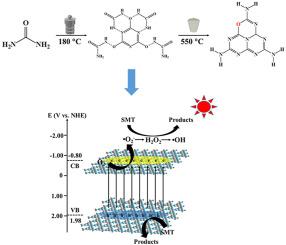Environmental Research ( IF 7.7 ) Pub Date : 2022-02-12 , DOI: 10.1016/j.envres.2022.112920 Shihai Cao 1 , Yu Zhang 2 , Keqiang Ding 1 , Jianhua Xu 3 , Yuqi Zhao 1 , Yi Wang 1 , Xianchuan Xie 4 , Huiya Wang 1

|
Graphitic carbon nitride (CN), as a non-metal material, has emerged as a promising photocatalyst to address environmental issues with the favorable band gap and chemical stability. The porous oxygen-doped CN nanosheets (CNO) were synthesized by an ecofriendly and efficient self-assembled approach using a sole urea as the precursor. The CNO photocatalysts were derived from the hydrogen-bonded cyanuric acid-urea supramolecular complex, which were obtained by pretreatment of urea at high temperature and pressure. The homogeneous supramolecular assembly was advantageous to the formation of uniform porous and oxygen-doped CN nanosheets. The formation process of the supramolecular intermediate and the CNO nanosheets were investigated. Moreover, doping amount of O in CNO could be controlled by the time of the high-pressure thermal polymerization of urea. The characterization results shown that the O atoms were successfully doped into the framework of CN by substitution the N atoms to form the C–O structures. The obtained CNO photocatalysts demonstrated the excellent visible-light photocatalytic performances for sulfamerazine (SMR) degradation, which was ascribed to synergistic interaction of porous structure and O doping. The degradation intermediates of SMR were identified and the degradation pathway were also proposed. Furthermore, density functional theory (DFT) calculations proved that O doping changed the electronic structure of CN, resulting in more easier to activate O2. This work provides a novel perceptive for the development of high-performance nonmetal photocatalysts by using the homogeneous supramolecular assembly, which exhibits great potential in the environmental treatment.
中文翻译:

氧掺杂石墨氮化碳通过尿素的均相超分子组装高效可见光驱动降解抗生素污染物
石墨氮化碳(CN)作为一种非金属材料,具有良好的带隙和化学稳定性,已成为解决环境问题的有前途的光催化剂。多孔氧掺杂的 CN 纳米片 (CNO) 是通过使用单一尿素作为前体的环保且高效的自组装方法合成的。CNO 光催化剂来源于氢键合的氰尿酸-脲超分子配合物,通过预处理得到高温高压下的尿素。均匀的超分子组装有利于形成均匀的多孔和氧掺杂的CN纳米片。研究了超分子中间体和CNO纳米片的形成过程。此外,CNO中O的掺杂量可以通过尿素高压热聚合的时间来控制。表征结果表明,通过取代N原子形成C-O结构,O原子成功地掺杂到CN骨架中。所获得的 CNO 光催化剂表现出优异的可见光光催化降解磺胺嘧啶 (SMR) 的性能,这归因于多孔结构和 O 掺杂的协同作用。鉴定了SMR的降解中间体,并提出了降解途径。此外,密度泛函理论 (DFT) 计算证明 O 掺杂改变了 CN 的电子结构,导致更容易激活 O2 . 这项工作为利用均相超分子组装体开发高性能非金属光催化剂提供了新的思路,在环境处理方面表现出巨大的潜力。






























 京公网安备 11010802027423号
京公网安备 11010802027423号